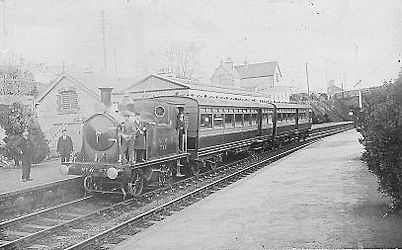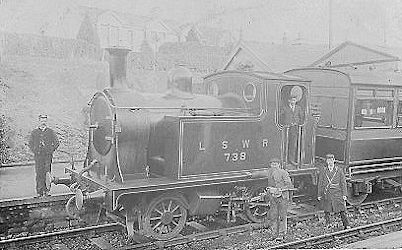|
OLD DEVONPORT
. UK |
||
|
© Brian
Moseley, Plymouth Webpage created: April 11, 2016 Webpage updated: March 23, 2020 |
||
|
RAILWAYS IN OLD DEVONPORT | LONDON AND SOUTH WESTERN RAILWAY COMPANY SAINT BUDEAUX SUBURBAN SERVICE
A LSWR suburban railmotor posed at Saint
Budeaux Station circa 1907. Prior to 1903 the area of Saint Budeaux was served by a rather inadequate tramway service provided by the Devonport and District Tramways Company. Its main route from the centre of Devonport ended at Camel's Head and passengers for Saint Budeaux had to walk across a rickety wooden bridge over Weston Mill Creek to catch another tram from the Weston Mill side of the Creek onward to Saint Budeaux Square. It was probably easier to catch a London and South Western Company train from Devonport Station if you wanted to go to Saint Budeaux. However, with the coming of the North Yard Extension of the Royal Dockyard, increased housing in the area and the construction of an embankment across Weston Mill Creek, the Railway faced competition from the newly connected-up tram system. A new suburban service was called for, similar to the Saltash Suburban Service that the Great Western Railway Company started in June 1904. In February of 1906, the London and South Western Railway Company decided to build three so-called 'motor trains' to run between Friary Station and Tavistock Station, each consisting of a railmotor and one trailer. The train would be capable of being controlled from either end. However, the Great Western had been operating these sort of trains since 1904 and at the March meeting of the LSWR Board Mr Drummond, their Chief Engineer, persuaded them to cancel the previous order and instead build six 'vestibule' cars and ten 0-4-0 locomotives. Each locomotive would haul two trailers, one all Third class, the other a Brake Third. They would be linked by a gangway enabling the conductor/guard to move between the two and issue tickets to passengers who boarded at unstaffed Halts. Mysteriously, apparently, the order got changed to a 2-2-0 tank locomotive, to be given the class number 'C14'.
A rather faded close-up photograph of 2-2-0 tank number 738. The most notable design innovation of the carriages was that access was through Bostwick-type folding and hinged ornamental gates, giving rise to the name "Gated Stock". Officially, they were called 'vestibule cars' because inside the gates was a vestibule running transversally across the carriage, from which access was gained to saloons on either side. The first to be delivered in October 1906 were Number 1, the 20-ton Trailer Third, built to drawing 1474, and Brake Third Number 2, also 20-tons, built to drawing 1475. The following month the remainder were delivered, numbers 3 and 5 being the Trailers and Numbers 4 and 6 being the controlling Brake Third vehicles. And so on Wednesday September 26th 1906 the new service was inaugurated but between Devonport Station and Saint Budeaux Station. Although it has been claimed that Albert Road Halt, in the gap between Devonport and Ford Tunnels, was opened on Monday October 1st 1906 and Camel's Head Halt and Weston Mill Halt on Thursday November 1st, the wording in the announcement in the Western Daily Mercury newspaper on that day suggests that the Halts were opened that day. It would appear that the Service was extended from Devonport Station to Friary Station as from Monday October 1st 1906, for which the single fare was 4½d. For the opening timetable CLICK HERE. Weston Mill Halt was closed on or from Wednesday September 14th 1921.
The Saint Budeaux Suburban Service was inherited by the
Southern Railway Company as
from Monday January 1st 1923. |
||

